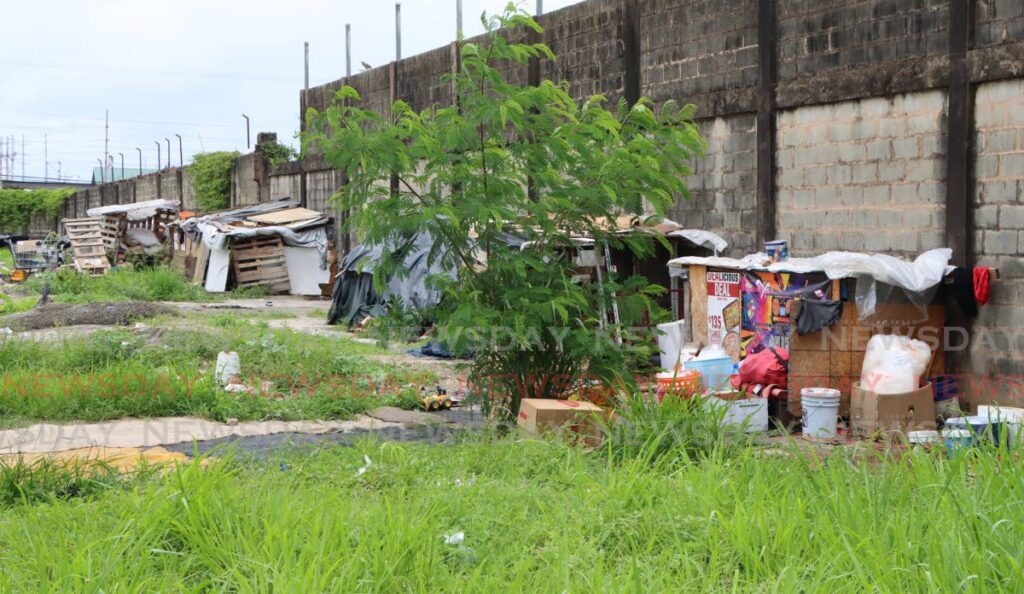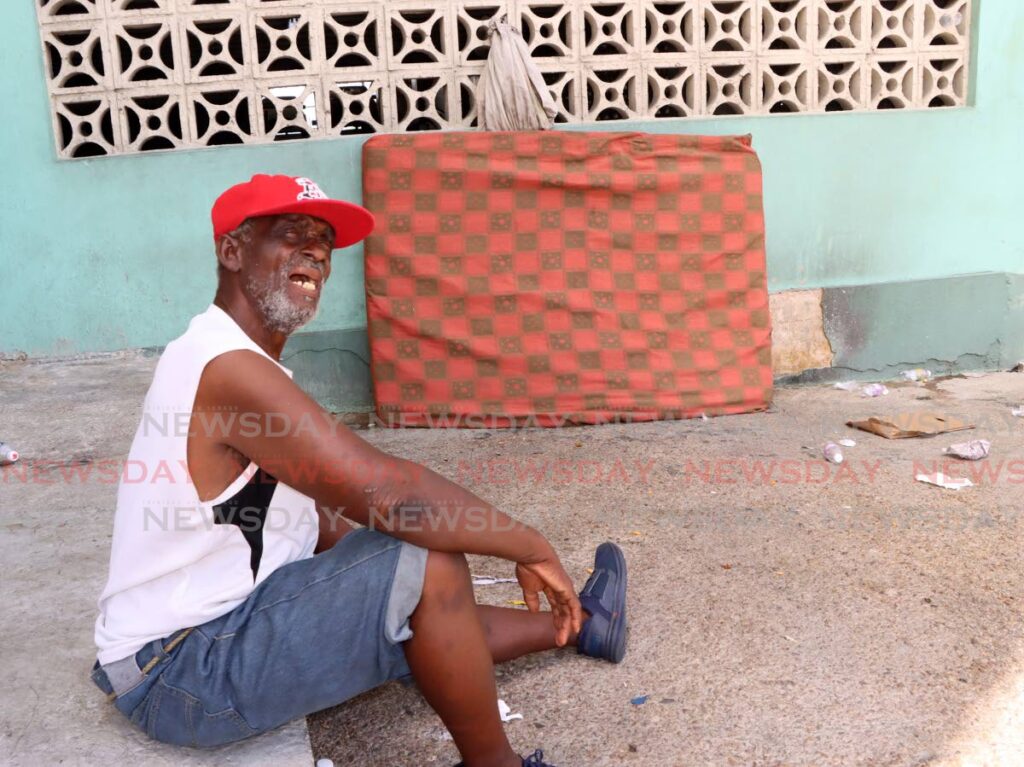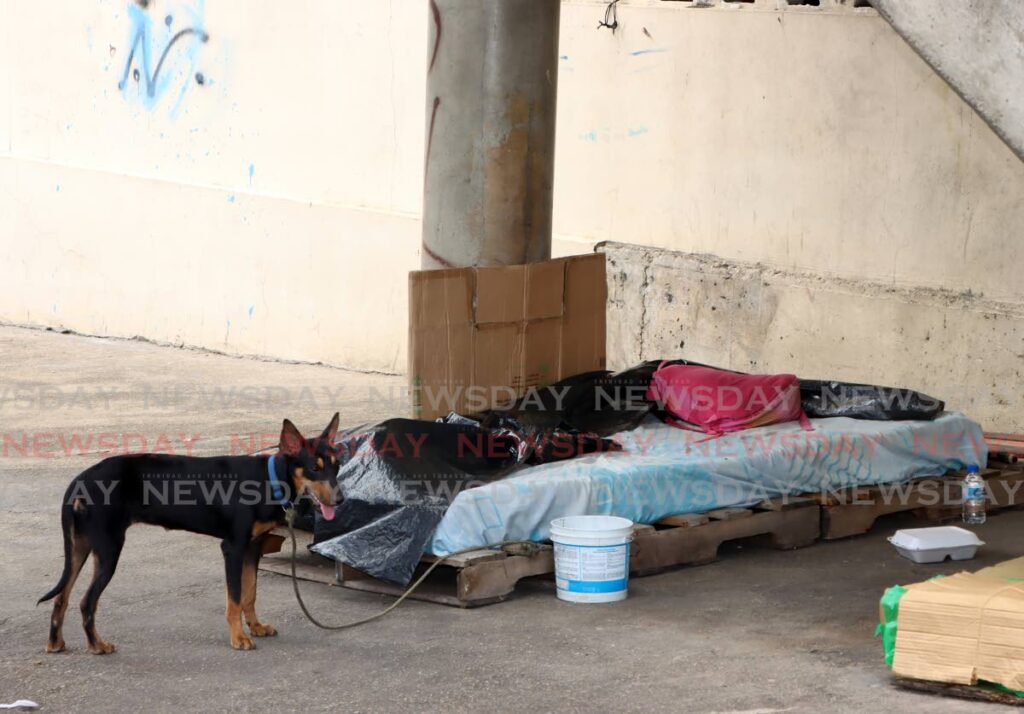Homeless camp outside closed Riverside shelter: 'We want freedom to move'

TWO months shy of the anniversary of the closure of the Riverside Homeless Shelter, at Riverside Plaza carpark, Port of Spain – after 32 years in operation – a group of homeless individuals have resettled in front the building, creating makeshift shelters using garbage bags, cloth, and cardboard.
An official count by the Ministry of Social Development and Family Services shows that as at July 13, there are 254 street dwellers in Port of Spain area – 239 males and 15 females. Of this, 198 males and 12 females live downtown Port of Spain, 34 males and one female are in the Woodbrook area, and seven males and two females in the Diego Martin district. The ministry said it will continue its count throughout the country in the coming days.
In 1991, the Society of St Vincent de Paul agreed to allow the government to use the facility as a temporary rehabilitation facility. In September 2022, government assessed and relocated 90 occupants before closing the facility. The society was disappointed by that decision.
Thirty-four of the shelter's displaced refused to be relocated to government facilities. Some of those who agreed were taken to another facility, while others were allowed to be taken to the homes of friends and family. At the time of the closure, just about three of them remained outside the building. Over the last 11 months that number has quadrupled. It seems a concerning trend has emerged among the homeless population, as those with whom Sunday Newsday spoke are opting to remain on the streets rather than seek shelter within government institutions due to the strict restrictions and other challenges they face.
But their presence on the streets has raised health and safety concerns for members of the public. On mornings, motorists driving into Port of Spain using the St Joseph Road have notice more mattresses, suitcases, cardboard structures, sheet tents and boxes of clothes lined along the pavement. For pedestrians, the area is becoming almost impassable as faeces, clothes left to dry on the pavement and other personal items take up a large area of the walkway.
When Sunday Newsday visited the area where the shelter used to be, just before noon on Friday, a handful of homeless people were relaxing on rusted chairs and some were sitting on the ground near the driveway of the building. There were at least six mattresses – two queen-sized and another four full-sized – propped against the building’s wall.
Speaking at a PNM public meeting a few weeks ago, the Prime Minister announced the construction of a five-storey Social Displacement and Transitional Facility to house up to 200 residents in Port of Spain. The sod-turning for the construction will happen some time in August. The new shelter site is located just across the road from the closed facility. A galvanise fence has already been erected around the construction site with a sign of the building’s final design.
While some of them told Sunday Newsday they welcome the new facility, others had concerns about the rules and accessibility.

Michael Spring, 34, said he had refused the government’s help when it was offered, weeks before the shelter closed.
“It’s true. I never went because how you could put me in a place I can’t come and go as I please?
“They put me in one of them (sic) place but I come out, I live on the street now. I vex they close down the shelter here. That’s madness. I would take the help if they come and offer it again but it’s the rules. You see the locking down...They do a set of madness and do what they want."
Another man who only identified himself as Thomas, said he has no intention of being "trapped" at a government institution.
Pointing to his mattress – placed under the step, on top two wooden crates on the eastern side of the building – neatly made up with a Newsday newspaper near the pillow and his dog tied, he said he’ll be comfortable once he has food.
Raymond Charbonier, who stays at a St Vincent De Paul facility, said he is open to accepting help from the government. He said the residents there (St Vincent De Paul) have gone without a stable electricity supply for weeks.
Another man said, “It makes no sense asking for help.” He said he spent 28 years living on the streets in the US moving from shelter to shelter each night.
“I don’t like how they closed down this shelter and then forcing you to go into a kind of home so you can’t go and come as you want. I want to come back and take my lime on the streets for how long I want...When they come and actually do something then you can come back and interview me.”
Casford George interjected, saying he was also against being put in a shelter with rules that “interfere with my freedom."
He said, “I was living upstairs for years, working with the government and assisting them with anything they want me assist with."
He claims he was evicted without explanation, weeks before the shelter’s closure.
“I never fight anything, they just put me out, then they close the shelter..."
He said the ministry never offered help or the option to relocate to another facility. But, he said, he is willing to take help from the ministry if it is offered.
He praised the prime minister for the new facility.
“That is a good thing. He supposed to render him help to people. That his duty."
Directly behind the building, a group of homeless individuals, who also lived in the closed shelter, formed a small makeshift community on a patch of land. Despite the shelter's closure, these individuals have come together, creating their own supportive network in their challenging circumstances.
One of its resident, Marvin Joseph said he was happy to hear about the new shelter. "That's great because people really suffering on the streets. A nation has a head and a bottom. If the bottom cant function, the head cannot because (we) the base man doing things the rich would not do to keep the country going in line of progress and development."

He said he fell destitute after becoming blind in one eye and was unable to work and pay a rent. He lived at the closed homeless shelter for almost a decade. He, along with the others, found pieces of board and other old materials from the Beetham landfill to build very small structures behind the old shelter after it closed.
Minister Donna Cox told Sunday Newsday her ministry had done all in its power to assist the affected residents. She said her ministry’s Social Displacement Unit is still willing to help those willing to be relocated.
“Some of them that didn’t want to be relocated had concerns over the freedom. They prefer to stay on the road.”
She said one of the main reasons why many of them returned to the Riverside location is because NGOs still go there with food donations throughout the day.
“It’s shocking to hear some of them when they were offered the option to relocate. There are some that may have been missed...We know some of them hid when they heard the ministry was coming to assess the residents to relocate them based on their needs.”


Comments
"Homeless camp outside closed Riverside shelter: ‘We want freedom to move’"